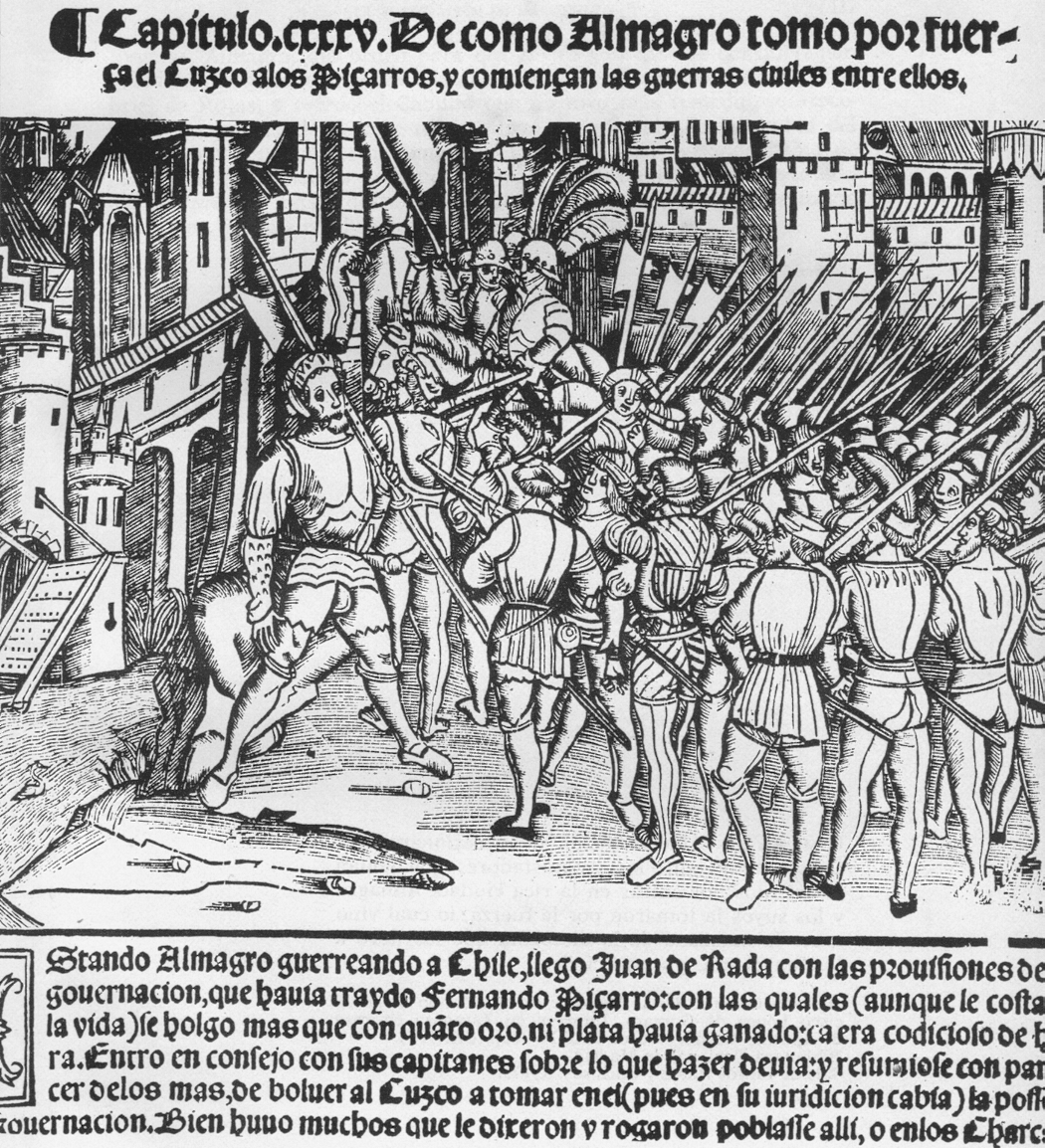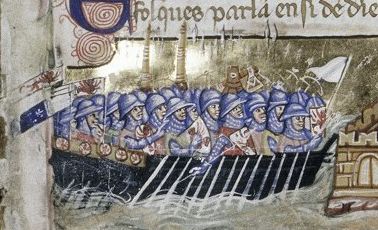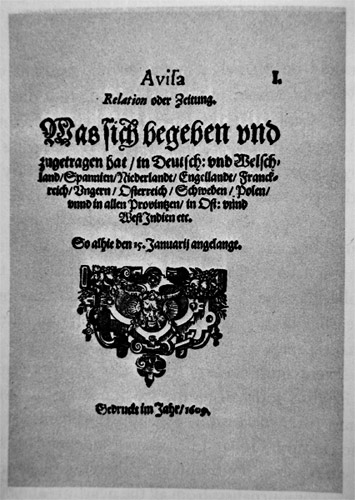|
August 25
Events Pre-1600 * 766 – Emperor Constantine V humiliates nineteen high-ranking officials, after discovering a plot against him. He executes the leaders, Constantine Podopagouros and his brother Strategios. * 1248 – The Dutch city of Ommen receives city rights and fortification rights from Otto III, the Archbishop of Utrecht. * 1258 – Regent George Mouzalon and his brothers are killed during a coup headed by the aristocratic faction under Michael VIII Palaiologos, paving the way for its leader to ultimately usurp the throne of the Empire of Nicaea. * 1270 – Philip III, although suffering from dysentery, becomes King of France following the death of his father Louis IX, during the Eighth Crusade. His uncle, Charles I of Naples, is forced to begin peace negotiations with Muhammad I al-Mustansir, Hafsid Sultan of Tunis. * 1537 – The Honourable Artillery Company, the oldest surviving regiment in the British Army, and the second most senior, is ... [...More Info...] [...Related Items...] OR: [Wikipedia] [Google] [Baidu] [Amazon] |
Constantine V
Constantine V (; July 718 – 14 September 775) was Byzantine emperor from 741 to 775. His reign saw a consolidation of Byzantine security from external threats. As an able military leader, Constantine took advantage of Third Fitna, civil war in the Muslim world to make limited offensives on the Al-'Awasim, Arab frontier. With this eastern frontier secure, he undertook repeated campaigns against the First Bulgarian Empire, Bulgars in the Balkans. His military activity, and policy of settling Christian populations from the Arab frontier in Thrace, made Byzantium's hold on its Balkan territories more secure. He was also responsible for important military and administrative innovations and reforms. Religious strife and controversy was a prominent feature of his reign. His fervent support of Byzantine Iconoclasm, iconoclasm and opposition to Christian monasticism, monasticism led to his vilification by some contemporary commentators and the majority of later Byzantine writers, who ... [...More Info...] [...Related Items...] OR: [Wikipedia] [Google] [Baidu] [Amazon] |
1537
Year 1537 ( MDXXXVII) was a common year starting on Monday of the Julian calendar. Events January–March * January 1 – Princess Madeleine of Valois, the 16-year-old daughter of François I, King of France, is married to King James V of Scotland in a ceremony at the cathedral of Notre-Dame de Paris. Already in ill health at the time of the marriage, Madaleine lives only six more months before dying at the Holyrood Palace in Edinburgh on July 7. * January 6 – Alessandro de' Medici, Duke of Florence is assassinated by Lorenzino de' Medici, a distant cousin, who claims that he wants to reintroduce republican rule but has to flee to Venice. Instead Cosimo I of the junior branch of the Medici becomes the new duke. * January 16 – Bigod's Rebellion, an uprising by Roman Catholics, led by Francis Bigod against Henry VIII of England and Protestant Rebellion, begins with an unsuccessful attempt to seize Scarborough Castle in Yorkshire. * January 19 &nd ... [...More Info...] [...Related Items...] OR: [Wikipedia] [Google] [Baidu] [Amazon] |
1630
Events January–March * January 2 – A shoemaker in Turin is found to have the first case of bubonic plague there as the plague of 1630 begins spreading through Italy. * January 5 – A team of Portuguese military advisers to China's Ming dynasty government arrive at Zhuozhou. Led by Gonçalo Teixeira Corrêa, and accompanied by interpreter João Rodrigues, the group begins training the troops of Governor Sun Yuanhua in using modern cannons. * January 11 – Otto III and his brother William Augustus, both, Dukes of Brunswick-Harburg, sell their rights to inherit rule of Brunswick-Lüneburg to Prince Christian for in return of his payment of their debts of more than 150,000 thaler. * January 13 – In China, General Yuan Chonghuan is invited to an audience with the Chongzhen Emperor and is arrested on charges of collusion with the enemy. Yuan is executed by the slow death on September 22. * January 18 – Nicolò Contarini is elected as ... [...More Info...] [...Related Items...] OR: [Wikipedia] [Google] [Baidu] [Amazon] |
Republic Of Venice
The Republic of Venice, officially the Most Serene Republic of Venice and traditionally known as La Serenissima, was a sovereign state and Maritime republics, maritime republic with its capital in Venice. Founded, according to tradition, in 697 by Paolo Lucio Anafesto, over the course of its History of the Republic of Venice, 1,100 years of history it established itself as one of the major European commercial and naval powers. Initially extended in the ''Dogado'' area (a territory currently comparable to the Metropolitan City of Venice), during its history it annexed a large part of Northeast Italy, Istria, Dalmatia, the coasts of present-day Montenegro and Albania as well as numerous islands in the Adriatic Sea, Adriatic and eastern Ionian Sea, Ionian seas. At the height of its expansion, between the 13th and 16th centuries, it also governed Crete, Cyprus, the Peloponnese, a number of List of islands of Greece, Greek islands, as well as several cities and ports in the eastern Me ... [...More Info...] [...Related Items...] OR: [Wikipedia] [Google] [Baidu] [Amazon] |
Galileo Galilei
Galileo di Vincenzo Bonaiuti de' Galilei (15 February 1564 – 8 January 1642), commonly referred to as Galileo Galilei ( , , ) or mononymously as Galileo, was an Italian astronomer, physicist and engineer, sometimes described as a polymath. He was born in the city of Pisa, then part of the Duchy of Florence. Galileo has been called the father of observational astronomy, modern-era classical physics, the scientific method, and modern science. Galileo studied speed and velocity, gravity and free fall, the principle of relativity, inertia, projectile motion and also worked in applied science and technology, describing the properties of the pendulum and "hydrostatic balances". He was one of the earliest Renaissance developers of the thermoscope and the inventor of various sector (instrument), military compasses. With an improved telescope he built, he observed the stars of the Milky Way, the phases of Venus, the Galilean moons, four largest satellites of Jupiter, Saturn's r ... [...More Info...] [...Related Items...] OR: [Wikipedia] [Google] [Baidu] [Amazon] |
1609
Events January–March * January 12 – The Basque witch trials are started in Spain as the court of the Spanish Inquisition, Inquisition at Logroño receives a letter from the commissioner of the village of Zugarramurdi, and orders the arrest of four women, including María de Jureteguía and María Chipía de Barrenetxea. * January 15 – One of the world's first newspapers, ''Avisa Relation oder Zeitung'', begins publication in Wolfenbüttel (Holy Roman Empire). * January 31 – The Bank of Amsterdam is established. * February 4 – The last day of Keichō, Keichō 慶長 13 (according to the Japanese calendar, Japanese lunar calendar). * March 11 – The Swedish Army, under the command of General Jacob De la Gardie, begins marching east from Vyborg (at this time, part of the Swedish Empire, modern-day Russia) in order to defend the Russian Empire against the Polish-Lithuanian Commonwealth in the course of the Polish–Muscovite War (1605– ... [...More Info...] [...Related Items...] OR: [Wikipedia] [Google] [Baidu] [Amazon] |
Iberian Union
The Iberian Union is a historiographical term used to describe the period in which the Habsburg Spain, Monarchy of Spain under Habsburg dynasty, until then the personal union of the crowns of Crown of Castile, Castile and Crown of Aragon, Aragon, incorporated the Kingdom of Portugal under the same terms, that existed between 1580 and 1640 and brought the entire Iberian Peninsula except Andorra, as well as Portuguese Empire, Portuguese and Spanish Empire, Spanish overseas possessions, under the Spanish Habsburg monarchs Philip II of Spain, Philip II, Philip III of Spain, Philip III, and Philip IV of Spain, Philip IV. The union began after the Portuguese succession crisis of 1580 and the ensuing War of the Portuguese Succession, and lasted until the Portuguese Restoration War, during which the House of Braganza was established as Portugal's new ruling dynasty with the acclamation of John IV of Portugal, John IV as the new king of Portugal. As a personal union, the Kingdom of Portug ... [...More Info...] [...Related Items...] OR: [Wikipedia] [Google] [Baidu] [Amazon] |
Battle Of Alcântara (1580)
The Battle of Alcântara took place on 25 August 1580, near the brook of Alcântara, in the vicinity of Lisbon, Portugal, and was a victory of the Habsburg King Philip II over the other pretender to the Portuguese throne, Dom António, Prior of Crato. Background In Portugal, the death of King Sebastian of Portugal in 1578, with only an elderly childless great uncle to succeed him, plunged the country into a succession crisis. King Philip II of Spain was one of seven who laid claim to the Portuguese throne, and in June 1580 a Spanish army of about 40,000 men (about half of which were German and Italian mercenaries) invaded Portugal, under the command of Don Fernando Álvarez de Toledo, Duke of Alba. Two years earlier, the Portuguese army had a major defeat at the Battle of Ksar El Kebir (1578), causing the death and imprisonment of thousands of Portuguese soldiers with some nobles. Dom António also lacked support from what was left of the Portuguese nobility and high clergy, ... [...More Info...] [...Related Items...] OR: [Wikipedia] [Google] [Baidu] [Amazon] |
War Of The Portuguese Succession
The War of the Portuguese Succession, a result of the extinction of the Portuguese royal line after the Battle of Alcácer Quibir and the ensuing Portuguese succession crisis of 1580, was fought from 1580 to 1583 between the two main claimants to the Portuguese throne: António, Prior of Crato, proclaimed in several towns as King of Portugal, and his first cousin Philip II of Spain, who eventually succeeded in claiming the crown, reigning as Philip I of Portugal. Cardinal-King The Cardinal Henry, great-uncle of Sebastian I of Portugal, became ruler in the immediate wake of Sebastian's death. Henry had served as regent for Sebastian after 1557, and succeeded him as King after the disastrous Battle of Alcácer Quibir in 1578. Henry renounced his clerical offices and sought to take a bride for the continuation of the Aviz dynasty, but Pope Gregory XIII, affiliated with the Habsburgs, did not release him from his vows. The Cardinal-King died two years later, without having a ... [...More Info...] [...Related Items...] OR: [Wikipedia] [Google] [Baidu] [Amazon] |
1580
1580 (Roman numerals, MDLXXX) was a leap year starting on Friday of the Julian calendar. Events January–March * January 31 – Portuguese succession crisis of 1580: The death of Henry, King of Portugal, with no direct heirs, leads to conflict between his potential successors, including King Philip II of Spain and Catherine, Duchess of Braganza, Infanta Catherine, Duchess of Braganza.Dionysius Lardner, ed., ''The History of Spain and Portugal'', vol. 5, part of the ''Cabinet Cyclopaedia''. London: Longman, Rees, et al., 1832. See pages 208-209. * February 16 – The massacre of 20 artists at the Mardi Gras festivities at the annual ''Carnaval de Romans'' during the festival takes place in France at Romans-sur-Isère. * February 28 – Three Jesuit priests from Portuguese Goa, including Rodolfo Acquaviva, arrive in Agra on the mainland of India as guests of the Mughal Empire, Mughal Emperor, Akbar the Great, who is curious about Christianity. The Emperor grant ... [...More Info...] [...Related Items...] OR: [Wikipedia] [Google] [Baidu] [Amazon] |
António Mota
António da Mota was a Portuguese trader and explorer who, in 1543, together with Fernão Mendes Pinto and Francisco Zeimoto, became one of the first Europeans to set foot in Japan. Voyage While traveling to Ningbo with a Chinese junk in 1543 (some sources say 1542), Mota and the rest of the crew were swept off course by a bad storm. Among the crew were around 100 East Asians and several Portuguese. The Portuguese included were Francisco Zeimoto, António Peixoto, and Mota himself. Fernão Mendes Pinto claimed that he was on the voyage as well, but this claim is unlikely since he also claimed (more accurately) that he was in Burma at the same time. Driven off course by the storm, the ship landed on the island of Tanegashima on 25 August 1543. António da Mota and Francisco Zeimoto are recognized as the first Europeans on Japanese soil. António Peixoto is not recorded as having landed, and presumably died at sea before the landing. Mota and Zeimoto introduced handheld guns ... [...More Info...] [...Related Items...] OR: [Wikipedia] [Google] [Baidu] [Amazon] |
1543
Year 1543 ( MDXLIII) was a common year starting on Monday of the Julian calendar. It is one of the years sometimes referred to as an " Annus mirabilis" because of its significant publications in science, considered the start of the Scientific Revolution. Events January–March * January 4 – Andrea Centurione Pietrasanta begins a two-year term as the new Doge of the Republic of Genoa, replacing Leonardo Cattaneo della Volta. * January 8 – The burial of King James V of Scotland is carried out at Holyrood Abbey. * February 11 – King Henry VIII of England allies with Charles V, Holy Roman Emperor, against France. * February 21 – Battle of Wayna Daga: A joint Ethiopian-Portuguese force of 8,500, under Emperor Gelawdewos of Ethiopia, defeats Imam Ahmad ibn Ibrahim al-Ghazi's army of over 14,000, ending the Ethiopian–Adal war. * March 7 – ** Abu Abdallah Muhammad VI is installed as the new ruler of the Kingdom of Tlemcen in what is now Al ... [...More Info...] [...Related Items...] OR: [Wikipedia] [Google] [Baidu] [Amazon] |








